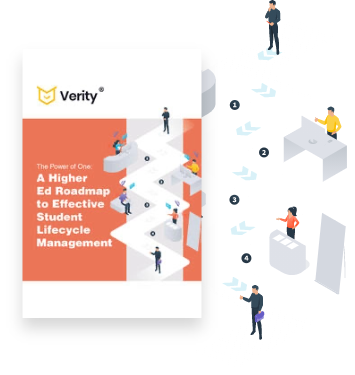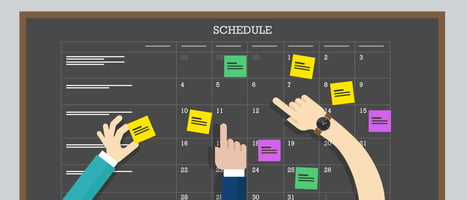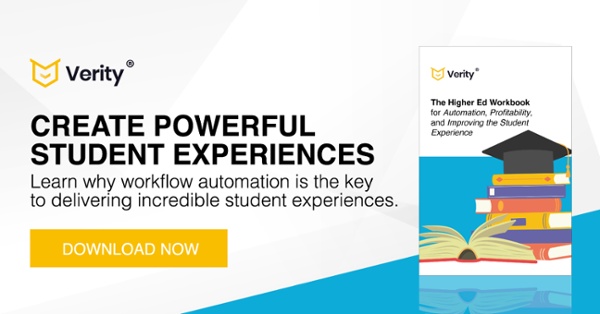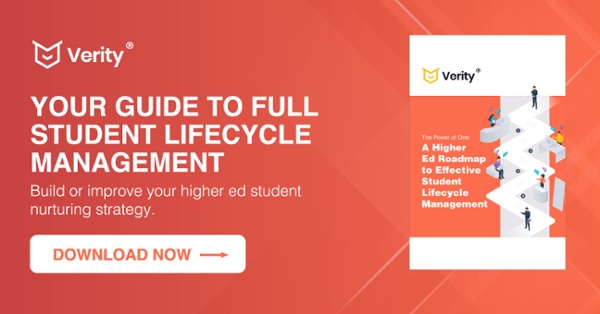Workflow automation has become quite the buzzword for the Higher Ed world over the past couple of years. It seems like every industry thought leader or new piece of technology has been preaching the importance of automation.
By now, you probably have some concept of how workflow automation works. But how exactly does it fit in with Higher Ed, and how can you maximize its potential at your institution?
We all know that Higher Ed has historically been slower to adapt to new technologies. To us, that just means that there is a ton of opportunity to make an immediate and long-lasting impact with a very low barrier of entry.
You may be ahead of the curve and already leveraging workflow automation at your school—if that’s you, that’s outstanding! Even so, there are likely some ways in which you can make an even bigger impact with efficiency and profitability.
For others, there is often some trepidation about invoking new technologies, especially when it comes to automation. What if the wrong alert goes out? What if tasks are executed in the wrong order? What if it just stops working one day?
In this guide, we’ll help dispel those common misconceptions about workflow automation and demonstrate how powerful it can be for your campus. Its utility in Higher Ed is almost endless, whether you want to create email nurturing workflows, emails triggered by forms, internal alerts, or contact updates.
These are just a few examples, but they can take a lot of time and resources to create and manage manually. By automating them with workflows, you can:
-
Make the lives of you and your team easier
-
Reduce staff burnout and fatigue
-
Improve the student experience
-
Free up time for more important initiatives
-
Increase profitability and the bottom line
Let’s take a deeper look at workflow automation in Higher Ed and how it can help your institution achieve the next level of success for efficiency, profitability, and overall staff happiness.
What can you do with Workflows?
The use cases for automation in Higher Ed are almost endless, but here are a few of our favorites.
It wouldn’t be an exaggeration to say that workflow automation and efficiency are practically synonymous.
If you feel like your team is spending too much time with manual work and you’re looking for ways to streamline the way you operate, workflow automation is the place to start.
The use cases for automation in Higher Ed are almost endless, but here are a few of our favorites.
 RMI Prospect Nurturing
RMI Prospect Nurturing
For many prospects, filling out a request for more information (RMI) form is the first conversion they have with your school. What happens next should feel like a warm, encouraging, and exciting embrace from your school that shows how much you appreciate their inquiry and how excited you are to be part of their journey.
That’s why it’s important to have workflows that are triggered at common entry points for your prospects such as RMI forms, premium content downloads, blog subscriptions, and event registrations.
People at the office get busy, take vacations, and sometimes just flat out forget—so if this process isn’t automated, it’s likely that some prospects could slip through the cracks or have a less-than-ideal experience with your school. That’s what makes it so important to have that automation built in to create touchpoints via email and SMS text (plus WhatsApp for international students).
Most importantly, be helpful. Create different nurturing workflows depending on their entry point and where they are on their journey. Someone who’s asking questions about the application process is likely in a different place from someone who is downloading an awareness-level guide about their program of interest.
Talking to prospective students and guiding them through their journey with thoughtful, proactive, and automated touchpoints will create a better student experience and also free up substantial time for your team.
 Event Promotion and Follow Up
Event Promotion and Follow Up
You’ve probably run one (or many!) event campaigns in the past, right?
Think back to your most recent one. How much time did you spend on it? How much internal back-and-forth was there? Was there a whole bunch of manual work that could have been automated?
Event campaigns are already one of the most involved and often cumbersome projects to tackle. If you’re not using workflow automation, they’re even more challenging.
So many pieces of the event campaign can be automated, whether it’s sending invitations and reminders, organizing registrants into contact lists, updating contact records, and creating internal tasks and alerts.
It’s also a best practice to use “smart” logic where you can. This can get really sophisticated, but it doesn’t have to be. At a minimum, you should be able to quickly determine which contacts on your invitation list have registered or not. If 10 people signed up for your event after the first email, then they shouldn’t receive the 2nd email asking them to register again.
Perhaps the most important part of the event, and often the most overlooked, is the follow-up campaign. Thoughtfully built automation can help you deliver proactive, action-oriented follow-up communication that helps prospects take that desired next step, whether it’s starting their application or downloading a valuable piece of content.
The best part of all of this? Event campaigns are super easy to templatize! Not only can you automate so much of each campaign, but you can also replicate that process for future events so that you’re not starting from scratch each time.
 Reporting
Reporting
Many Higher Ed professionals that we speak with have told us that their teams have to manually pull reports in order to get valuable data, which is both a time-consuming and labor-intensive process. On top of that, this approach also creates many opportunities for human error.
By automating your reports, you can reduce the chances of human error, cut back on the time it takes to pull this data manually, ensure compliance with 90-10, WIA, and VA funding, and have a single source of truth that makes it all possible.
To do this, of course, you’ll need to have the right tool in place that can help you automate these reports and make you feel 100% confident in the data.
 Enrollment and Class Registration
Enrollment and Class Registration
Enrollment and class registration are areas that can involve a ton of manual work if you have to send out lots of reminders, manually schedule classes, and chase down students who miss important deadlines, just to name a few.
These are also spaces with very little margin for error since they can impact things like class scheduling, financial aid, faculty management, budgeting, and more. So, this is definitely an area in which you want to streamline your operations and minimize the chance of human error.
The good news is that you can automate a ton of tasks here, such as registrar meetings, class schedules, enrollment, email and SMS text communications, and registration deadlines. It’ll take a little more work upfront if you’re building them for the first time, but it’ll save you hours of repetitive work in the long run.
And, like with event planning in the previous section, you can templatize workflows to re-use them at each enrollment cycle so that you can take what works, build upon it, and cut back on the manual work.
That last part is important. Just because you can replicate the process doesn’t mean you shouldn’t evaluate it after each use to see what worked, what didn’t, and where you can improve. It may take several iterations of workflows for you to figure out what really works best.
For more insights, check out our blog: How to Streamline Your Enrollment Management Process.
 Student Retention
Student Retention
If you’re looking to increase profitability at your school, leveraging workflow automation in your student retention efforts is one of the most effective places to start. This will have a huge impact on the bottom line, which we’ll get into in the next section.
It’s no secret that enrollment numbers in Higher Ed are down across the board. In times like these, it’s absolutely critical that you maintain strong student retention numbers.
Workflow automation can help with that.
Think about the most important milestones for students over the course of an academic year. What comes to mind? Maybe it’s when they’re changing majors, attending campus events, approaching final exams, going on holiday breaks, scheduling academic advisor appointments, things of that nature.
Now, have you thought about how you’re going to help them navigate through those scenarios? Building proactive workflows that offer valuable insights and clear pathways for success will strengthen your relationship with your students and position your school as a trusted, valued guide.
Perhaps even more importantly, help your students through their most challenging times. With automation software, you can build alerts for at-risk students who miss a certain amount of classes or have a low GPA. Reach out with a helping hand and a personal touch to let them know you care and that you’re there as a resource—it will go a long way to help student retention.
To help get you started, we’ve put together this Higher Ed Roadmap that gives you ideas, insights, and quick tips to deliver incredible value at every step of the student lifecycle.
 Alumni Giving Campaigns
Alumni Giving Campaigns
If your school is like most, then you rely on fundraising and the generosity of your alumni network to help fund your operations. So, utilizing automation with alumni giving campaigns will play a key role in profitability as well.
How much of your alumni outreach is automated, and how much of it is done manually?
Of course, you don’t want to sacrifice the personal touch, but building automated campaigns can still deliver the results you need without all of the time-consuming manual work. Whether you’re using email, SMS text, WhatsApp, phone calls, or even direct mail, automation can be leveraged to make your lives easier.
Streamlining your alumni giving campaigns can go a long way toward increasing efficiency while still reaching your fundraising goals.
For more ideas on how to do that, check out these 21 Communications Templates we put together. Inside, you’ll find actionable, ready-to-go templates for alumni giving and every other step of the student journey.

The Higher Ed Workbook for Automation, Profitability, and Improving the Student Experience
This must-have workbook for Higher Ed professionals will help you identify gaps and explore new opportunities to level up your operations. With the questions in this guide, you can facilitate honest, productive, and positive conversations at your institution.
How do Workflows Affect the Bottom Line
Improving efficiency, productivity, and the student experience will all help your institution run like a more streamlined organization.
Improving efficiency, productivity, and the student experience will all help your institution run like a more streamlined organization.
That's why workflow automation and profitability go hand-in-hand.
Here’s how.
 Reducing Staff Turnover
Reducing Staff Turnover
Like many other industries, Higher Ed has seen an increase in staff turnover, whether it’s people switching careers or going to another school.
Why do people quit their jobs?
When they feel stressed out, overwhelmed, bored, unchallenged, or a combination of them all.
Workflow automation can help with this by limiting the amount of mundane, repetitive, and boring tasks that might take up a large chunk of their day currently. Instead, they can free up their time to focus on larger initiatives that inspire, challenge, excite, and energize them.
By giving your team the opportunity to work on projects like that, you’re creating a situation in which you’ll enjoy higher staff retention.
 Minimizing the Chance for Human Error
Minimizing the Chance for Human Error
There are few things more frustrating for business leaders than when someone on their team made a mistake that will cost time, money, and resources to resolve. This is especially true when those mistakes are easily avoidable.
The reality is that these mistakes can be avoided with the help of workflow automation.
When people are doing the same repetitive tasks every day, they tend to get into a rhythm where they’re simply in production mode. Think about class scheduling, for example. When someone is manually scheduling students for classes, one at a time, for hundreds or even thousands of students, it can be easy to make a mistake.
If you’re automating class scheduling and other repetitive tasks, you’ll greatly reduce the chance of human error and the costs that come with it.
 Improving the Student Experience
Improving the Student Experience
On that note, what kind of projects would you and your team be able to work on if your time was freed up from repetitive, mundane tasks? What’s on your dream to-do list that you never seem to be able to get to?
Maybe it’s planning even better events or organizing new student activity groups. Or, maybe it’s simply having more time to engage with and listen to your students to figure out what it is they need and how you can best support them.
Whatever it is you take on, that time freed up by leaning more heavily on workflow automation will help you create a more powerful student experience. Ultimately, that is what we as Higher Ed professionals are always after, isn’t it?
When you create a better student experience, you’ll increase student retention which is a crucial ingredient for creating a healthy bottom line.
 Automating Faculty Management
Automating Faculty Management
As we outlined in our blog post, The Importance of Faculty Management: Class Scheduling Tips to Maximize the Bottom Line, proactive class scheduling plays a key role in making sure that the courses you offer are profitable.
This is an area that’s vastly overlooked by schools and it’s a way to make a huge impact on the bottom line. Classes that are too large are not a great experience for the instructor or their students. Classes that are too small aren’t profitable.
Without the right automation in place, you might not have insights into this until it’s too late and you’re left scrambling at the last minute or simply taking the financial hit on that class. After all, the faculty member gets paid the same whether they have 4 students in the class or 30, right?

Improving the Bottom Line One Step at a Time
It won’t happen overnight, but leveraging workflow automation software is one of the biggest ways to increase efficiency, improve productivity, and impact the bottom line in a major way.
To get started, it’ll take some commitment from you and the team to build the “engine” upfront. It’ll involve some creative and critical thinking to map out new processes, build a game plan, assign roles, and then actually create all of that automation.
Once you’ve done that, however, you’ll have the software working harder, working smarter, and taking care of those repetitive tasks so that you can focus on things more worth your time and energy.
It’s also important to keep in mind that not just any software will do. There are lots of automation technology options out there, so how can you know which is right for you?
You should start by looking at the software solution that’s built for Higher Ed professionals by Higher Ed professionals.
That’s something we hang our hat on here at Verity, and we’d love to help you reach new heights when it comes to profitability and efficiency. Ready to take that next step? Click the link below to schedule a demo and we’ll help show you the way!
Additional Reading
If you’re looking for more insights into increasing efficiency and improving the student experience, here are some resources you might find helpful:

Are You Providing a Stale Student Experience? Here's How to Tell
Read Now →

5 Features You Absolutely Need from Your Class Scheduling Software
Read Now →

















